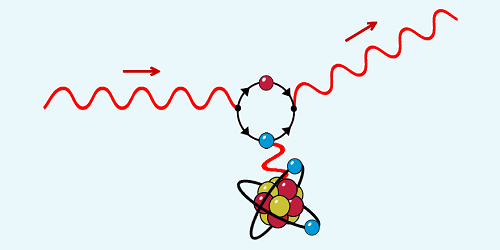Quantum Deflection Unraveled
The sky owes its color to a process known as Rayleigh scattering, in which light bounces off electrons bound to atoms. Quantum physics permits an analogous effect, dubbed Delbrück scattering, whereby photons deflect from the electrostatic field around atomic nuclei. Now Jonas Sommerfeldt at the Technical University of Braunschweig, Germany, and his colleagues present highly accurate calculations of this quantum deflection [1]. The results should aid the analysis of nuclear photon-scattering experiments that could increase knowledge of nuclear structure.
According to quantum theory, empty space is not actually empty but teeming with particle–antiparticle pairs that flit in and out of existence. Delbrück scattering occurs when photons interact with such pairs in the electrostatic field of a nucleus. The probability that this process happens is encoded in a quantity called the Delbrück cross section. In the case of heavy nuclei, the values of this quantity obtained from theoretical calculations have disagreed with those extracted from experimental data for at least half a century.
Sommerfeldt and his colleagues developed a way to compute the Delbrück cross section that is accurate for a wide range of photon energies and nuclei. The key innovation is the use of a mathematical function that can account for typically neglected contributions to the cross section. As a demonstration, the researchers applied their technique to the Delbrück scattering of high-energy photons by plutonium nuclei. Unlike previous calculations, this one returned a cross section that matches the experimental value, thus resolving the aforementioned discrepancy. The team says that this computational method should enable sensitive tests of quantum electrodynamics—the fundamental theory describing how light and matter interact.
–Ryan Wilkinson
Ryan Wilkinson is a Corresponding Editor for Physics Magazine based in Durham, UK.
References
- J. Sommerfeldt et al., “All-order Coulomb corrections to Delbrück scattering above the pair-production threshold,” Phys. Rev. Lett. 131, 061601 (2023).




